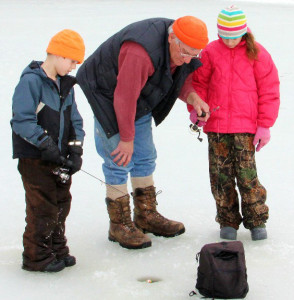Ice fishing tutorial, Part 1: Tips to stay safe
Somebody once asked me, “Now that winter has arrived and you can’t fish anymore, what are you going to do?”
“Well,” I replied, “I’m going to continue to fish just like I did all summer.”
The fact is I fish every month of the year and the winter months are no exception and judging from the number of people I’m seeing on the ice on a Saturday afternoon the ranks of the “frozen chosen” are steadily growing.
Trust me, when you drive by a lake and you spot those little black dots out on the ice peering down a hole, they are very likely having fun. If done properly and safely ice fishing can be fun for the whole family.
This piece is actually the first in a three part series to help those who are interested in the activity and may even want to get involved themselves. To learn more about staying comfortable on the ice, click here. For tips on how to be a successful ice angler, click here.
Even if you don’t want to venture onto a frozen lake these articles will hopefully give you a better understanding of what ice fishing is all about.
Yes it’s true, there are some dangers involved in ice fishing but then again the greatest danger is probably the drive to and from the lake. The fact is we likely take greater risks driving to and from work on a daily basis or driving to the mall.
Like everything else we do in life, there are some things we can do to minimize the risks involved when pursuing fish through the hard water.
First, if you are new to the activity I would highly recommend that you go with someone who is experienced and exercises good judgment. I add the “good judgment” part because not all veteran ice fishermen fall into the good judgment category, so choose wisely.
Next, begin learning the characteristics of safe ice, but be aware that there are no hard, fast rules that can be relied on all the time and under all circumstances.
Generally speaking, most ice fishermen are comfortable going out on a minimum of four inches of hard, clear ice while some prefer at least six inches of good ice. Be aware, however, that ice on a lake is not always uniform over its entire surface.
Most lake surfaces freeze at different rates in different locations and for different reasons. Wind, current, springs and even wildlife like ducks swimming around can keep a spot from freezing as quickly as other areas of the lake.
Recently my brother was leaving a lake after an afternoon of ice fishing when he encountered a middle-aged woman and her teenage son about to embark on a different portion of the lake. The lady informed him that they had attended a seminar on ice fishing and they were first-timers so they didn’t want to go where all the other fishermen were until they learned more about the activity.
My brother told the woman that the area of the lake they were about to step out on dropped to a depth of nearly 15 feet almost immediately and the day before it was open water — there was probably barely an inch of ice. They decided to go where the other fishermen were.
Don’t assume that because there are fishermen on the other side of the lake you can take any route to get to the same water. There may be serious, unknown hazards on your chosen route. I make it a habit to “watch” a lake freeze up for a week or two so I have a better idea of what areas to avoid — this year that is especially important given the up-and-down temperatures we have this year.
I also drill frequent holes on my way out the first trip and I actually measure the ice thickness — in fact I do that anytime I have doubts. You might want to consider some of these same points even if you’re just planning on some ice skating on a local pond.
An additional safety measure would be to wear a life vest. Admittedly I did not do that especially once I was confident the ice had reached sufficient levels in all areas of the lake I was fishing.
In recent years myself, my brother and a fishing friend have all purchased special ice fishing outer wear that is very warm, light weight, comfortable and, more importantly, the suit will keep you afloat if you should go through the ice — it essentially acts as a life preserver.
Another item you should have in your ice fishing arsenal is a pair of hand-held ice picks. The picks clamp together keeping the metal spikes out of harms way and they are hung around the neck with a lanyard. Should you fall through, you dislodge the picks quickly and drive them into the ice to help pull yourself out.
Another item that is a must is ice cleats. These cleats that fit to the bottom of your boots come in a variety of types and they all attach differently. Find a pair that you’re happy with and when the ice is slick wear them.
Snow-covered ice is generally not a problem — but wet, shinny ice can be a real walking hazard. A couple of years ago, a group of us were out on a slick surface and one of our members failed to put his ice cleats on in a timely manner. As he was hurriedly heading back to his ice sled, he slipped and fell straight back on the back of his head. Our friend refused treatment and remained out on the ice all day — albeit with an accompanying headache.
Check out the other two parts of my ice fishing tutorial: Tips to stay comfortable and tips to be a successful ice angler.


